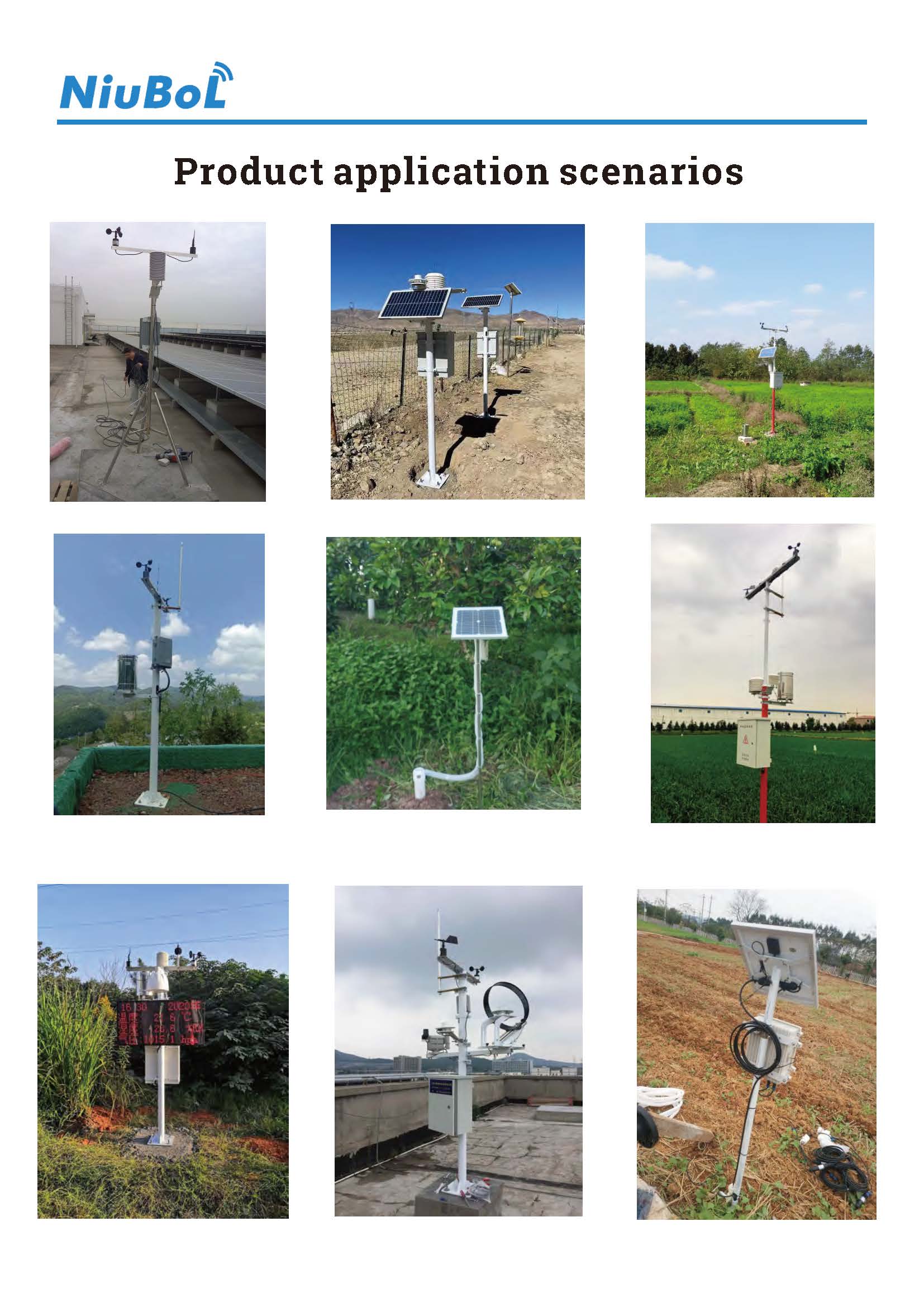

— Blogs —
—Products—
 Consumer hotline +8618073152920
Consumer hotline +8618073152920 WhatsApp:+8615367865107
Address:Room 102, District D, Houhu Industrial Park, Yuelu District, Changsha City, Hunan Province, China
Product knowledge
Time:2024-10-01 18:15:29 Popularity:1292
Weather Station for golf course: precise monitoring to optimize course management and player experience
Golf courses, as high-end leisure and competitive sports venues, depend heavily on weather conditions for their operations and player experience. In order to cope with the changing weather conditions and improve the service quality of golf courses, golf course weather stations have been developed. This paper will introduce the function, importance, working principle and its application in the course management of golf course weather station in detail.

The golf course weather station integrates a variety of sensors, capable of real-time monitoring and recording a variety of meteorological elements inside and outside the course, including but not limited to:
Temperature: Sensing the ambient temperature through a thermal element to provide players with appropriate attire recommendations, while helping course managers adjust irrigation schedules.
Humidity: Measures the amount of water vapor in the air using capacitive or resistive principles to help determine if the turf needs additional irrigation.
Barometric Pressure: Measures the amount of gas pressure exerted per unit area, which is informative in predicting weather changes.
Wind Speed and Direction: Utilizing equipment such as wind cups and wind vane, wind speed and direction are accurately measured to advise players on their hitting strategies and to help course managers assess the impact of wind on the fairways.
Precipitation: Using rainfall sensors, the amount of precipitation is recorded in real time, providing data to support the course's drainage system and irrigation program.
Light: Measures the intensity of solar radiation, helping to determine whether the grass needs shading protection, as well as advising players on sun protection.
UV: Monitors the intensity of UV rays to provide players with sun protection guidance to protect their skin health.
Air quality monitoring: Through PM2.5, PM10 and other particulate matter sensors, the air quality of the stadium is monitored to provide players with health advice, especially in areas with haze or sandstorms.
Soil pH and EC Monitoring: Measure soil pH and conductivity to help managers understand soil nutrient status, apply fertilizer precisely and maintain lawn health.
Evapotranspiration (ET) Monitoring: Calculates the amount of water evaporating and transpiring from the soil and plant surfaces, combining with weather data to more accurately plan irrigation and save water.
Radar Precipitation Prediction: Utilizes radar data to predict precipitation in the next few hours and take measures in advance, such as closing the court and adjusting the playing time.
Sound monitoring: Monitoring noise levels on the course through sound sensors to ensure that players enjoy their golf without being disturbed by outside noise.
In addition, some advanced weather stations may also include monitoring of elements such as soil moisture, soil temperature, and special subsurface temperatures (e.g., tarmac temperatures) to meet the unique management needs of golf courses.
1. Enhance players' experience: Through real-time monitoring of weather changes, it provides players with personalized service suggestions, such as dress code, sunscreen, hitting strategy, etc., so as to enhance the players' overall experience.
2. Optimize course management: Weather data provides course managers with a scientific basis for decision-making, such as irrigation plans, turf maintenance, drainage system optimization, etc., which helps reduce operating costs and improve course quality.
3. Ensure tournament safety: When organizing golf tournaments, weather stations can warn of inclement weather in advance to ensure that the tournament is conducted safely.
4. Promote scientific research: meteorological data can also be used for golf course climate change research, for the course design, grass selection, etc. to provide a scientific basis.
The working principle of golf course weather station is mainly based on sensor measurement, data acquisition and processing, communication module and data display and other links.
1. Sensor measurement: various sensors are responsible for measuring and detecting various meteorological elements, and transforming meteorological elements into processable electrical signals.
2. Data Acquisition and Processing: The data acquisition system receives the electrical signals sent by the sensors and converts them into the values of meteorological elements. In the process of data acquisition, the system will screen, calibrate and correct the data to ensure the accuracy and reliability of the data.
3. Communication module: The weather station transmits the data to the central meteorological department or other related organizations through wired or wireless means (e.g. satellite, wireless network, etc.) for further analysis and application.
4. Data display: the weather station is usually equipped with LCD or touch screen display equipment, which is convenient for users to view the current meteorological data intuitively.

1. lawn management: according to the weather data to adjust the irrigation plan, fertilization plan and lawn pruning plan, to ensure the healthy growth of lawn.
2. Tournament organization: when holding golf tournaments, the weather station can warn of bad weather in advance to ensure the safety of the tournament. At the same time, the weather data can also provide tournament organizers with personalized tournament scheduling advice.
3. Player service: Provide personalized service suggestions for players, such as dress code, sun protection, hitting strategy, etc., to enhance the overall experience of players.
4. Climate research: Meteorological data can be used for golf course climate change research, providing scientific basis for course design and grass selection.
1. Intelligent irrigation system integration: Combine weather station data with intelligent irrigation system to realize automatic adjustment of irrigation volume and irrigation time according to real-time weather conditions and improve water utilization efficiency.
2. Player health monitoring: set up health monitoring stations at key locations on the field, combining weather data to provide players with heart rate, blood pressure and other health indicators to prevent sports injuries.
3. Optimization of energy management system: Using meteorological data to optimize the operation of lighting, air-conditioning and other energy systems, such as adjusting lighting brightness according to light intensity and temperature to reduce energy waste.
4. Dynamic adjustment of fairway difficulty: Dynamically adjust the difficulty coefficient of the fairway according to the wind speed, humidity and other meteorological conditions to provide a fairer competitive environment for players of different levels.
5. Emergency Response System: Combined with the meteorological warning, it establishes an emergency response mechanism, such as the automatic closure of the course facilities in case of thunder and lightning warning to ensure the safety of the players.

1. Historical data analysis: long-term storage and analysis of meteorological data, identification of seasonal patterns of change and extreme weather events, providing a basis for long-term planning for the course.
2. Data visualization platform: build a meteorological data visualization platform to visually display meteorological data in the form of charts and maps, which is convenient for managers to quickly understand and make decisions.
3. AI prediction model: Using artificial intelligence algorithms, combining historical meteorological data and real-time data to build a weather prediction model to improve the accuracy of weather forecasts and provide longer warning time for course operations.
Through the above elements, the golf course weather station not only becomes a comprehensive weather monitoring platform, but also an important support for intelligent management and personalized service of the course. These functions and applications will further enhance the management efficiency of golf courses and player experience, and promote the development of golf to a greener, smarter and healthier direction.

Conclusion
As an important tool for golf course management and player experience, the importance of golf course weather station is self-evident. Through real-time monitoring and recording of a variety of meteorological elements, the weather station provides course managers with a scientific basis for decision-making, and also provides personalized service advice for players. With the continuous development of science and technology, the functions of the golf course weather station will be more and more abundant and the application will be more and more extensive, contributing to the sustainable development of golf.
Prev:Value of Building a Golf Course Weather Station
Next:What is the difference between wireless weather station and a wired weather station?
Related recommendations
Sensors & Weather Stations Catalog
Agriculture Sensors and Weather Stations Catalog-NiuBoL.pdf
Weather Stations Catalog-NiuBoL.pdf
Related products
 Combined air temperature and relative humidity sensor
Combined air temperature and relative humidity sensor Soil Moisture Temperature sensor for irrigation
Soil Moisture Temperature sensor for irrigation Soil pH sensor RS485 soil Testing instrument soil ph meter for agriculture
Soil pH sensor RS485 soil Testing instrument soil ph meter for agriculture Wind Speed sensor Output Modbus/RS485/Analog/0-5V/4-20mA
Wind Speed sensor Output Modbus/RS485/Analog/0-5V/4-20mA Tipping bucket rain gauge for weather monitoring auto rainfall sensor RS485/Outdoor/stainless steel
Tipping bucket rain gauge for weather monitoring auto rainfall sensor RS485/Outdoor/stainless steel Pyranometer Solar Radiation Sensor 4-20mA/RS485
Pyranometer Solar Radiation Sensor 4-20mA/RS485
Screenshot, WhatsApp to identify the QR code
WhatsApp number:+8615367865107
(Click on WhatsApp to copy and add friends)
